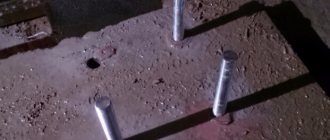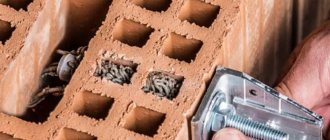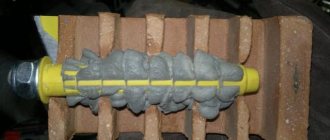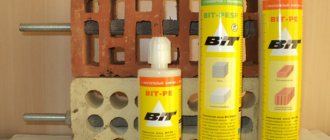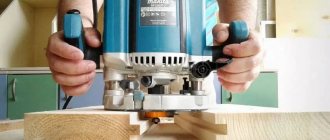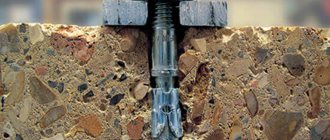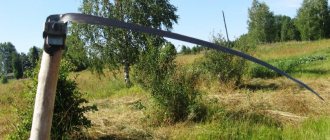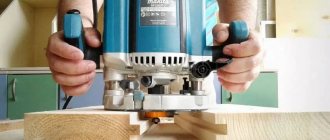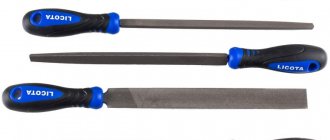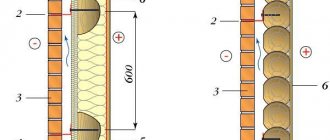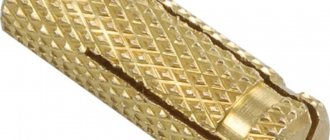Scope of application of chemical anchor
Chemical anchors for concrete are used when connecting critical structural elements at all stages of construction, building construction, laying subway lines, fastening mine arches in the mining industry and in everyday life during the construction of houses, cottages with porous concrete, fastening doors, windows, and furniture to walls.
- When constructing foundations of buildings and structures at high humidity and low temperatures,
- Construction of high-rise buildings, skyscrapers, exhibition centers, production workshops,
- Connecting bridge spans, arches, beams, trusses,
- Fastening metal parts to concrete bases,
- An auxiliary element for tying reinforcement under the foundation,
- When laying subway tunnels, strengthening mines in the mining industry,
- Installation and installation of high-voltage power lines, especially in areas of rivers, lakes, swamps, permafrost areas,
- Repair and construction of roads, highways, runways, construction of ports, shipyards, underground bunkers,
- Entertainment industry, installation of prefabricated foundations, industrial buildings, shopping centers, water parks, ski lifts,
Installation of equipment, machines, transformers, conveyors, loading equipment,
The use of chemical anchors is advisable in the construction of any facility, from the infrastructure of pipelines, stations and ending with the arrangement of plots, cottages, houses and living rooms.
Material advantages
The main advantage of this modern material is that the adhesive fills all the voids and roughness that occur between the anchor and the hole. Thanks to the strong chemical bond, the load on the material is evenly distributed. The chemical anchor and the base surface become one. Therefore, this fastening method is much more reliable than mechanical.
This fastener can be adjusted. This means that during installation work the insertion depth or position of the stud may be changed. However, this should only be done before the chemical composition has hardened.
This type of anchor provides a unique opportunity to attach to the edge of the base material. The quality of installation remains high. The elements are often used for underwater construction work or in areas with high humidity.
This is the optimal, and often the only mounting option. Especially if you need to fix a heavy object on a base with low density, that is, on surfaces made of foam blocks, clinker bricks, shell rock, aerated concrete, and various hollow blocks. If the installation and operation rules are followed, the service life of fasteners is at least 50 years.
Fastener design
There are two types of anchorage depending on the location and method of applying the adhesive:
- The himanker is attached using an injection glue gun, which is loaded with two capsules of resin and hardener. Using piston pressure, their contents are squeezed out of the containers and mixed into a homogeneous mass in the nozzle of the gun using a spiral. The adhesive composition is fed into a drilled hole with an anchor rod fixed in it. The solution fills the entire volume of voids around the fasteners, including voids in brick or foam block.
- The glass capsule contains the active component of glue and hardener, separated by a partition. The mounting hole is drilled along the diameter of the capsule. The container is inserted into the prepared recess and a pin is inserted using a drill or hammer, which breaks the wall of the capsule. The adhesive and hardener are mixed to firmly secure the stud into the wall. Glass shards additionally reinforce the fastening.
Important! The capsule anchor is not used for vertical fastening in ceilings. The glue may leak and the connection will not form.
A chemical anchor consists of several parts that form a connection:
- Adhesive based on phenol-formaldehyde, polyurethane or polystyrene resin,
- The hardener accelerates the drying process of the adhesive composition,
- Fillers increase the strength and reliability of the connection, usually quartz sand or cement is used,
- A metal rod in the form of a bolt, pin, nail or piece of reinforcement.
Definition and characteristics
According to the terminology of the system of European technical standards and building regulations, these structural elements are defined as “glued-in anchor” or “glued-in reinforcement”. In addition to the names mentioned above, there is another term both in the retail network and among users that bears the name of the market leader in this sector and applies to all similar products, regardless of type and type. In the territory of the Customs Union, the products of this company are declared under various names, for example:
- Hilti adhesive anchors type HIT-HY 100 and HIT-HY 110 with threaded rods and bars made of periodic profile reinforcement (Technical certificate No. 4704−15 confirming suitability for use in construction).
- The company's numerous product ranges, such as HIT-RE, HIT-HY, HIT-ICE, HIT-MM, HFX, HVU (Certificate of Conformity No. ROSS LI. AG81. H05061) are declared as “Chemical Anchors”.
From the point of view of the mechanism of action, the first name is more correct and technically correct. The basis of the technology is the use of adhesive compositions based on various types and types of synthetic resins.
Characteristics of these materials: high mechanical and chemical strength in the cured state; resistance to moisture and temperature, fungi and mold; high adhesion to various building materials (concrete, brick, stone, metal, plasterboard, wood, polymers, glass). The combination of these properties determined the possibility of using a fundamentally new technology for such critical and traditionally mechanical load-bearing elements as anchors.
By definition, an anchor is a fastening element for fastening or holding any structures on a supporting base. The main types of construction anchors differ precisely in the method of fastening:
- In mechanical anchors, fastening and retention in the base occurs due to the expansion of the spacer sleeve or collet of the anchor in the base material.
- Foundation anchor bolts are inserted into the well made in the foundation and filled with concrete. Retention at the base is ensured by a shank bent at 90° or by welding to the reinforced frame of the foundation.
- The chemical anchor is held in place by filling the volume between the rod or sleeve of the anchor and the walls of the hole made at the base with an adhesive composition.
Himanker for aerated concrete
The porosity of aerated concrete blocks used for the construction of building walls ranges from 40 to 85%. This material is not suitable for attaching heavy hanging structures, furniture elements, suspended ceilings, cabinets to it using nails, dowels or expansion anchors. It uses a chemical anchor for aerated concrete.
Types of fastening depending on the adhesive composition:
- In addition to strong, reliable fixation, epoxy-acrylic adhesive is fire-resistant, frost-resistant, and has a hardening time of 15 to 180 minutes.
- Polyester or polyester reagent is used at room temperature, curing time is from 25 minutes.
- Based on vinylester resin. The reagent is safe for metal, does not cause corrosion, is used in conditions of high humidity, hardening time is up to 24 hours.
- Epoxy adhesive is used when working with all types of concrete. Used for interior and exterior work, moisture-resistant, non-corrosive, used when using smooth fittings and studs without threads.
Advantages and disadvantages
Perhaps the only drawback of glued-in anchors is their price. Typically, this disadvantage disappears over time as technology develops and production volumes expand. Evidence of this is the presence on the market of many manufacturers offering different types of their products, including budget versions. In addition to the already mentioned Hilty and Fischer, you can name Mungo, DeWalt, Sormat, MKT.
Another disadvantage, compared to mechanical analogues, is the required time for the adhesive to harden. If glued reinforcement is used instead of foundation bolts, then there is a gain in time - a day for the adhesive mass or a week for concrete. In this case, the time from installation to application of load can be considered an advantage.
The advantages also include a wide selection of devices for various types of foundations: glued fastenings, unlike mechanical ones, have proven themselves in structures made of hollow bricks and blocks, from sheet materials, when repairing old concrete foundations, including hydraulic structures, when installing in hard-to-reach areas. places.
Originally posted 2018-07-04 07:45:18.
Liquid nail for hollow bricks
A chemical anchor for hollow bricks reliably fixes the stud in the hole, filling all nearby voids with adhesive. A strong connection is obtained due to the large area of adhesive, which seeps through the pores, cracks and voids in the base of the material.
For these purposes, injection formulations are used, which are loaded into an injection gun. Use the cartridges until they run out of substance. Tubes have a volume of up to 400 ml. Polyurethane, acrylic, phenol-formaldehyde and other types of glue are used as fillers.
Technology of use
Do-it-yourself installation of chemical anchors does not require special equipment or training. It is easy to do it yourself if you have a tool that every owner has.
Mark the intended location for fastening. Using a hammer drill with a diamond tip drill, drill holes that should be 2 mm larger than the diameter of the anchor pin or bolt.
Carefully remove dust from the middle.
- Insert an ampoule of glue into the hole, tighten the bolt or pin with an electric drill or hammer it in.
- If a cartridge is used, squeeze out the adhesive until the hole is completely filled, and insert the pin.
- Wait until the components specified in the attached instructions are completely dry and proceed with further installation.
Each type of anchorage is supplied with detailed instructions by the manufacturer, which explain in detail all stages of the work. The instructions must be strictly followed.
